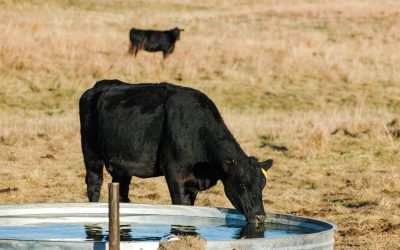
In the cool of spring, plan for the heat of summer
“Best practices” help cattle feeders keep cattle comfortable
by Miranda Reiman
As soon as the planters are in the shed, the crew at Weborg Feeding Co. near Pender, Neb., will unpack the shades in preparation for summer in the yard.
The 16 portable tarp systems they’ve purchased in the last two years are just one more step in their effort to minimize heat stress on finished animals.
“Shades have been a great addition, another tool for the toolbox,” says Tyler Weborg, who co-manages the 25,000 head feedlot with his dad Kent. “I wouldn’t say they’re a cure all, but they’ve worked in combination with sprinklers.”
The family consulted with Terry Mader, retired Nebraska beef Extension specialist, to develop a plan for dealing with the problem days: the hot, humid and still. He says shade is just one of the many management and facility options producers have to help their animals through those times.
“You really shouldn’t go into the summer without a heat mitigation plan,” says Mader, who recently summarized decades of research into, “Guidelines for Managing Heat Stress in Feedyard Cattle.”
The best management practices, developed for Certified Angus Beef LLC, can be found at www.cabcattle.com/best-practices.
“All cattle, of all sizes, shapes and kinds can be under heat stress,” he says. “It’s a continuum where the blacks and dark reds will absorb the most solar radiation but the whites absorb some, too. And all of those things are confounded with body condition, hair coat and feed intake.”

Terry Mader
Similarly, there is no single solution.
“There is a low probability that just one thing is going to be the sole solution, but it will take the edge off,” Mader says. “Shade is a good one. It certainly will eliminate the most severe part of the heat load, but you have to understand that there are more things you can do to keep the animals comfortable. You can pick and choose. You don’t have to do them all, but these are the things at your disposal.”
Other suggestions include moving processing times to cooler times of day, wetting portions of the pen’s surface or using sprinklers, and altering feeding schedule or ration.
“If you do at least one thing, it’s better than nothing,” he says, “but if you can do two or three things, then you have a greater chance of minimizing that impact and maintaining the cattle on feed.”
For the Weborgs, portable options allow them to place relief in the pens at highest risk, like those with animals closest to marketing.
“The combination of the shade and sprinklers gets the cattle spread out and gives them a chance to move between the sprinkler, the bunk, the tank and back to the tank,” Weborg says. “In observing them, they rotate in and out.”
Although there is an initial investment, he says “shades pay for themselves pretty quickly” when figuring lost gain and other potential health problems associated with heat stress. Mader also notes decreased dark cutters and quality grade impacts with cooling strategies.
“We did see some hard numbers on our performance, where in years previous cattle maybe went off feed, but with the shade and sprinklers, it seemed like they stayed more consistent,” Weborg says. “They were more comfortable and they continued to eat throughout the day.”
That appetite is a good sign.
“There is climatic and metabolic heat stress, and one of the main mechanisms the animal will have is that he’ll just stop eating so that he can drop that metabolic heat load,” Mader says.

Mader suggests producers monitor the weather conditions carefully, poised with a plan to respond.
“If you need to have extra water space, have the tanks available and a mechanism to fill them,” he offers as an example.
Seventy degrees. That’s a critical number for Weborg.
“If the temperature doesn’t get below 70 degrees overnight and through the early morning, cattle don’t have a chance to cool off,” he says. “You keep an eye on cattle movement. If cattle start milling around, looking for air, you better get a plan in place and keep ahead of them.”
Humidity and air flow are other significant variables to watch.
It would be easier if there was a one-size-fits-all approach, Mader says, “but when you’re dealing with an external environment you have no control of, that’s a variable component you have to be aware of relative to the welfare of the animal.”
In the feeding belt, most of the “heat events” occur from July 1 to August 15. Although true heat emergencies are somewhat rare, Weborg says it’s important for both themselves and their feeding customers to know they’re prepared.
“We try to do the best job we can,” he says.
To see all the best practices, visit https://cabcattle.com/best-practices
You may also like
Senses and sense
Humans developed over millennia to hunt and herd. When it’s time to move animals, instincts send us out with a purpose but sometimes little thought to how our aggressive behavior affects what they do. Stepping into a cattle pen, we naturally act the predator, manipulating where animals go. But good handling practices should turn us into leaders, says Kip Lukasiewicz.
Rising to the occasion
We know what keeps an animal healthy, but do we know what they want? Lily Edwards-Callaway, of Colorado State University, shared animal welfare research during Cattlemen’s College session at the 2020 Cattle Industry Convention that she tag-teamed with NCBA’s Shawn Darcy.
What technology can’t do
Technology has done a lot for making rancher jobs easier—like automatic waterers. But nothing can replace the human side of stockmanship.



